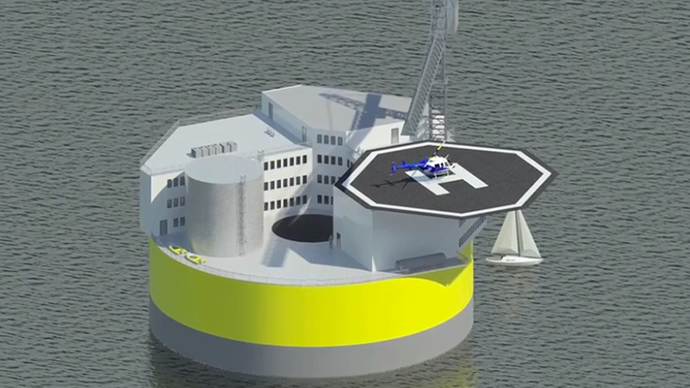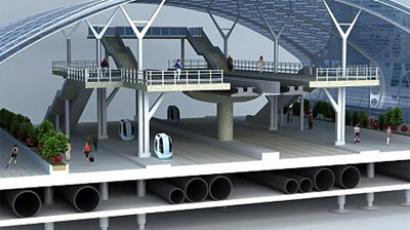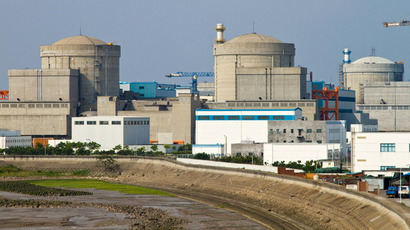Avoiding another Fukushima: Nuclear power generation could be put to sea

A group of American engineers proposed bringing nuclear power generating facilities out to sea, to secure them from earthquakes and tsunamis, and prevent a possible meltdown threat by submerging a reactor’s active zone.
A report by American scientists to be presented at the Small Modular Reactors Symposium, hosted by the American Society of Mechanical Engineers, suggests that a nuclear power plant could be built in a form of standardized floating offshore platforms similar to modern drilling oil rigs and anchored about 10km out into the ocean. Electric power would be transferred to land by underwater cables.

Jacopo Buongiorno, associate professor of Nuclear Science and Engineering at the Massachusetts Institute of Technology (MIT), who led the research, believes the project has a number of crucial advantages.
The main peculiarity of the new project is that a reactor is put into the underwater part of the facility, where it would be securely cooled by seawater in case of an emergency.
“The ocean itself can be used as an infinite heat sink. The decay heat, which is generated by the nuclear fuel even after the reactor is shutdown, can be removed indefinitely,” Buongiorno said, adding that “The reactor containment itself is essentially underwater.”

Such NPP would be safe from earthquakes and also from tsunamis inflicted by aftershocks. Back in 2011, a combination of these two devastated the Fukushima nuclear power plant in Japan, which led to breakdown of the reactors’ cooling systems and eventually ended with meltdown of two reactors’ active cores. Radioactive fallout from that catastrophe is set to contaminate the Pacific Ocean for many years to come.
Positioning the plant should also be a simple process: just tow the station to wherever it is needed and moor it to the seafloor. No need to look for a seismically safe place with plenty of water, a sea or lake, nearby as with traditional nuclear power plants.
“The ocean is inexpensive real estate,” Buongiorno said.
The all-steel sea-based construction of the facility also eliminates the need for expensive concrete works, which make up a considerable part of the cost of any nuclear power plant.
Buongiorno stressed the versatility of the project which could be adjusted to match any energy consumption need, be it 50 or 1,000 megawatts.
“It's a flexible concept,” he said.
The personnel of the plant could work on rotating scheme, with living quarters placed atop of the facility.
When the working lifespan of such plant is expired, it could be decommissioned the same way it is currently done nuclear submarines’ reactors, a well-proven technology considerably less expensive than decommission of a ground-based nuclear power plant.
The project is being developed by MIT Professors Jacopo Buongiorno, Michael W. Golay, Neil E. Todreas and other MIT staff, with support from the University of Wisconsin, and the major US nuclear plant and offshore platform construction company Chicago Bridge and Iron.
Developers of the project believe the concept could be required by many countries, in the first place earthquake- and tsunami-prone Japan, Indonesia, Chile etc.
Russia’s floating nuclear power plant nearly complete
The idea of constructing sea-based nuclear power facilities is definitely not new yet only one country has so far managed to bring such a project to reality.
Russia is in the process of finalizing construction of a 70 megawatt floating nuclear co-generation plant named ‘Akademik Lomonosov’, after a famous Russian scientist of the 18th century. The project implies construction of a series, probably seven, of vessel-mounted, non-self-propelled autonomous power facilities.
Launched in 2010 by state-owned Rosatom nuclear energy corporation, the project is now in the final stage of construction at the Baltic shipyard in St. Petersburg.

The vessel hosting the plant is measured 140 by 30 meters and with 5.5-meter draught has a displacement of 21,500 tons. The crew of the plant consists of 70 engineers.
The power unit of the plant consists of two 35MW KLT-40C nuclear reactors and two steam-driven turbines.
The plant will be generating enough power to serve 200,000 people.
Unlike the floating plant proposed by the American engineers, ‘Akademik Lomonosov’ is not just a power generator. It also produces 300 megawatt of heat that could be transferred onshore. This will be equal to saving 200,000 tons of coal every year.
This is the major difference between the Russia’s nuclear power plant and American project, which sacrificed heat generation to security matters. An American plant moored 10km off the coast cannot transfer hot water ashore so it will waste the heat and only warm up the waters nearby.
The facility could also be converted into desalination plant producing 240,000 cubic meters of fresh water per day, an immensely interesting solution for seaside countries with scarce water resources situated in Northern Africa and the Middle East.
The plant, with a lifespan of 40 years, will be re-fueled every three years and will have a 12-year service cycle, when the plant will undergo servicing and maintenance at the Baltic shipyard.
The equipment for the floating power plant has been developed and supplied by 136 companies and subcontractors.

Deployment of a nuclear facility out to sea have raised concerns of such environmental organizations as Greenpeace, which maintained that sea-based nuclear facility is prone to torpedo and missile attacks and could also be seized by terrorists striving to obtain nuclear materials for a ‘dirty’ nuclear bomb.
For all that Russia has well over 50 years of experience of operating nuclear powered icebreakers, nuclear submarines and other vessels, most of them specifically built for operation in the extreme conditions of the Arctic Ocean.
That’s why Rosatom is considering deployment of floating nuclear power plants to any region with either difficult weather conditions, such as the port of Pevek in the Russian Arctic or Vilyuchinsk on the Kamchatka Peninsula in Russia’s Pacific region, notorious for frequent seismic activities.














